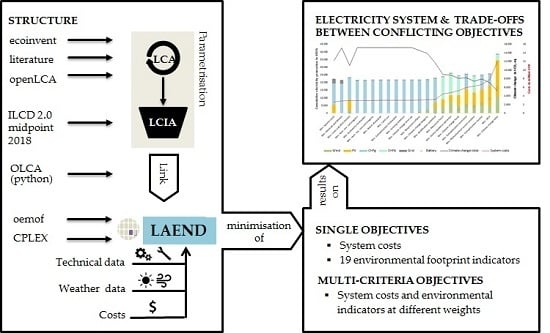LAEND: A Model for Multi-Objective Investment Optimisation of Residential Quarters Considering Costs and Environmental Impacts
Abstract
:1. Introduction
- indicators under consideration as both conventional and renewable energy systems impact different environmental categories, and in terms of;
- life cycle phases under consideration as the impact of conventional energy systems on the one hand and renewable energy systems on the other hand, concentrates on different stages of the life cycle.
2. Materials and Methods
2.1. Energy System Modelling Framework Oemof
2.2. Life Cycle Assessment with openLCA and Ecoinvent
2.3. Life Cycle Assessment Based Energy Decision Support Tool LAEND
- the parametrisation of the LCA data for implementation into oemof,
- the installation of a link between oemof and openLCA, and
- the integration of LCA parameters into oemof and the extension of the objective function to implement a multi-criteria sustainability array.
2.4. Benefits and Drawbacks of the Selected Approach
2.5. Research Design and Data Assumptions
- system costs,
- each of the 19 EF indicators (climate change (biogenic), climate change (fossil), climate change (land use), climate change (total), acidification potential, freshwater ecotoxicity, freshwater eutrophication, marine eutrophication, terrestrial eutrophication, human toxicity (carcinogenic), ionising radiation, human toxicity (non-carcinogenic), ozone depletion potential, photochemical ozone creation, respiratory effects, water dissipated, fossil resources, land use, mineral and metal resources),
- a multi-criteria environmental objective named JRCII to minimise the total environmental impacts applying normalisation and weighting factors provided by the European Commission’s Joint Research Centre (JRC) to the EF indicators as listed in Table A1 of Appendix A (cf. [36,37]) (the following impact categories are not considered as no weighting and normalisation factors are available: climate change biogenic, climate change fossil, and climate change land use.), and
- a combined multi-criteria objective targeting the minimisation of normalised system costs and normalised JRCII weighted each 50% (labelled Costs and JRCII (50:50)).
3. Results and Discussion of the Application to a Typical Residential Quarter in Germany
3.1. Electricy Mix and Installed Capacity under Different Optimisation Objectives
3.2. Trade-Offs Between the Optimisation Objectives
- To determine the absolute distance, the minimum absolute value for an indicator (received by the single criteria optimisation for this indicator) is subtracted from each resulting absolute value for this indicator of other optimisation runs (single optimisation runs for other indicators and multi-criteria optimisation runs).
- This received absolute distance is divided by the minimum absolute value for normalisation.
- The result shows by which factor the value is higher than the minimum.
3.3. Energy System and Trade-Offs Using Altered Weights
- all normalised environmental indicators have equal weights (1/16) (in analogy to the JRC weighting set climate change fossil, climate change land use and climate change biogenic are excluded to avoid double counting), the weight for system costs is set to zero (thus, optimisation only for environmental impacts), and
- all normalised environmental indicators and normalised total system costs are assigned the same weight (1/17).
4. Limitations of the Study
5. Conclusions
Supplementary Materials
Author Contributions
Funding
Conflicts of Interest
Appendix A
| Indicator | JRCII Weighting | JRCII Normalisation |
|---|---|---|
| Climate change biogenic | 0 | 1 |
| Climate change fossil | 0 | 1 |
| Climate change land use | 0 | 1 |
| Climate change total | 0.2106 | 5.34998 × 1013 |
| Acidification potential | 0.062 | 3.83 × 1011 |
| Ecotoxicity freshwater | 0.0192 | 8.14693 × 1013 |
| Eutrophication freshwater | 0.028 | 17,600,000,000 |
| Eutrophication marine | 0.0296 | 1.95 × 1011 |
| Eutrophication terrestrial | 0.0371 | 1.22 × 1012 |
| Human toxicity carcinogenic | 0.0213 | 265,544.3645 |
| Ionising radiation | 0.0501 | 2.91018 × 1013 |
| Human toxicity non-carcinogenic | 0.0184 | 3,274,782.609 |
| Ozone depletion potential | 0.0631 | 161,052,494.6 |
| Photochemical ozone creation | 0.0478 | 2.8 × 1011 |
| Respiratory effects | 0.0896 | 4,390,385.028 |
| Water dissipated | 0.0851 | 7.90869 × 1013 |
| Resources fossil | 0.0832 | 4.5 × 1014 |
| Land use | 0.0794 | 9.20229 × 1015 |
| Minerals and Metals | 0.0755 | 399,000,000 |
| Technology | Dataset Adaption | Process Name | Source | Dataset Unit | Scaling Factor LAEND |
|---|---|---|---|---|---|
| CHP biogas (CHPb) | Separation of input flows | biogas, burned in micro gas turbine 100 kWe [CH]–electricity, low voltage removed input flows: methane, 96% by volume, from biogas, low pressure, at user; micro gas turbine, 100 kW electrical; storage, 10,000 L | ei v3.5 | kWh | 1 |
| Scaling of separated input flow | methane production, 96% by volume, from biogas, from high pressure network, at service station [CH] | ei v3.5 | MJ | 1 kWh | |
| Scaling of separated input flow | micro gas turbine production, 100 kW electrical [CH] | ei v3.5 | unit | 1/100 kW/ 20 a | |
| Scaling of separated input flow | market for storage, 10,000 L [GLO] | ei v3.5 | unit | 1/100 kW/ 20 a | |
| CHP natural gas (CHPg) | Separation of input flows | natural gas, burned in micro gas turbine, 100 kWe [CH]–electricity, low voltage removed input flows: natural gas, low pressure; micro gas turbine, 100 kW electrical; storage, 10,000 L | ei v3.5 | kWh | 1 |
| Scaling of separated input flow | market for natural gas, low pressure [CH] | ei v3.5 | m−3 | 1/39 MJ m−3 kWh (39 MJ/m−3, ecoinvent inquiry) | |
| Scaling of separated input flow | micro gas turbine production, 100 kW electrical [CH] | ei v3.5 | unit | 1/100 kW/ 20 a | |
| Scaling of separated input flow | market for storage, 10,000 L [GLO] | ei v3.5 | unit | 1/100 kW/ 20 a | |
| PV | Separation of input flows | electricity, photovoltaic, 3 kWp slanted-roof installation, multi-Si [DE] removed input flow: photovoltaic flat-roof installation, 3 kWp, multi-Si, on roof | ei v3.5 | kWh | 1 |
| Scaling of separated input flow | photovoltaic, 3 kWp slanted-roof installation, multi-Si, on roof [DE] | ei v3.5 | unit | 1/3 kW/30 a | |
| Wind | Separation of input flows | electricity production, wind, <1 MW turbine, onshore [DE] removed input flows: wind power plant, 800 kW, fixed parts; wind power plant, 800 kW, moving parts | ei v3.5 | kWh | 1 |
| Scaling of separated input flow | market for wind power plant, 800 kW, fixed parts [GLO] | ei v3.5 | unit | 1/800 kW/ 20 a | |
| Scaling of separated input flow | market for wind power plant, 800 kW, moving parts [GLO] | ei v3.5 | unit | 1/800 kW/ 20 a | |
| Grid (Import) | Scaling | electricity, high voltage, production mix [DE] | ei v3.5 | kWh | 1/0.98 (efficiency low voltage) |
| LFP Battery | Scaling, efficiency adjustment | battery, Lithium-ion LFP-LTO | [47] * | kg | 1/0.0379 kWh0.9/15 a |
| VRF Battery | Scaling, efficiency adjustment | vanadium redox flow battery | [48] * | kg | 1/0.0194 kWh 0.75/15 a |
Appendix B
| Environmental Weighting | Electricity Generation (MWh) |
|---|---|
| 0.0 | 22,381.77 |
| 0.1 | 22,514.79 |
| 0.2 | 22,619.05 |
| 0.3 | 22,724.41 |
| 0.4 | 22,880.13 |
| 0.5 | 23,070.91 |
| 0.6 | 23,316.54 |
| 0.7 | 23,572.06 |
| 0.8 | 23,965.22 |
| 0.9 | 24,697.52 |
| 1.0 | 25,456.47 |
| Electricity Generation (MWh) | |||||||
|---|---|---|---|---|---|---|---|
| Optimisation Objective | Sum (w/o Batteries) | Wind | PV | CHP Gas | CHP Biogas | Grid | Batteries |
| Min: Costs and environmental impacts (same weights) | 21,748.06 | 1302.90 | 3750.52 | 16,667.48 | 0 | 27.16 | 36.16 |
| Min: Environmental impacts (same weights) | 21,747.48 | 1416.69 | 3735.57 | 16,570.66 | 0 | 24.57 | 87.59 |
| Min: Costs and JRCII (50:50) | 23,070.91 | 2264.33 | 5900.84 | 14,832.79 | 0 | 72.95 | 50.85 |
| Min: JRCII | 25,456.47 | 4939.87 | 12,961.90 | 7553.31 | 0 | 1.39 | 17,573.82 |
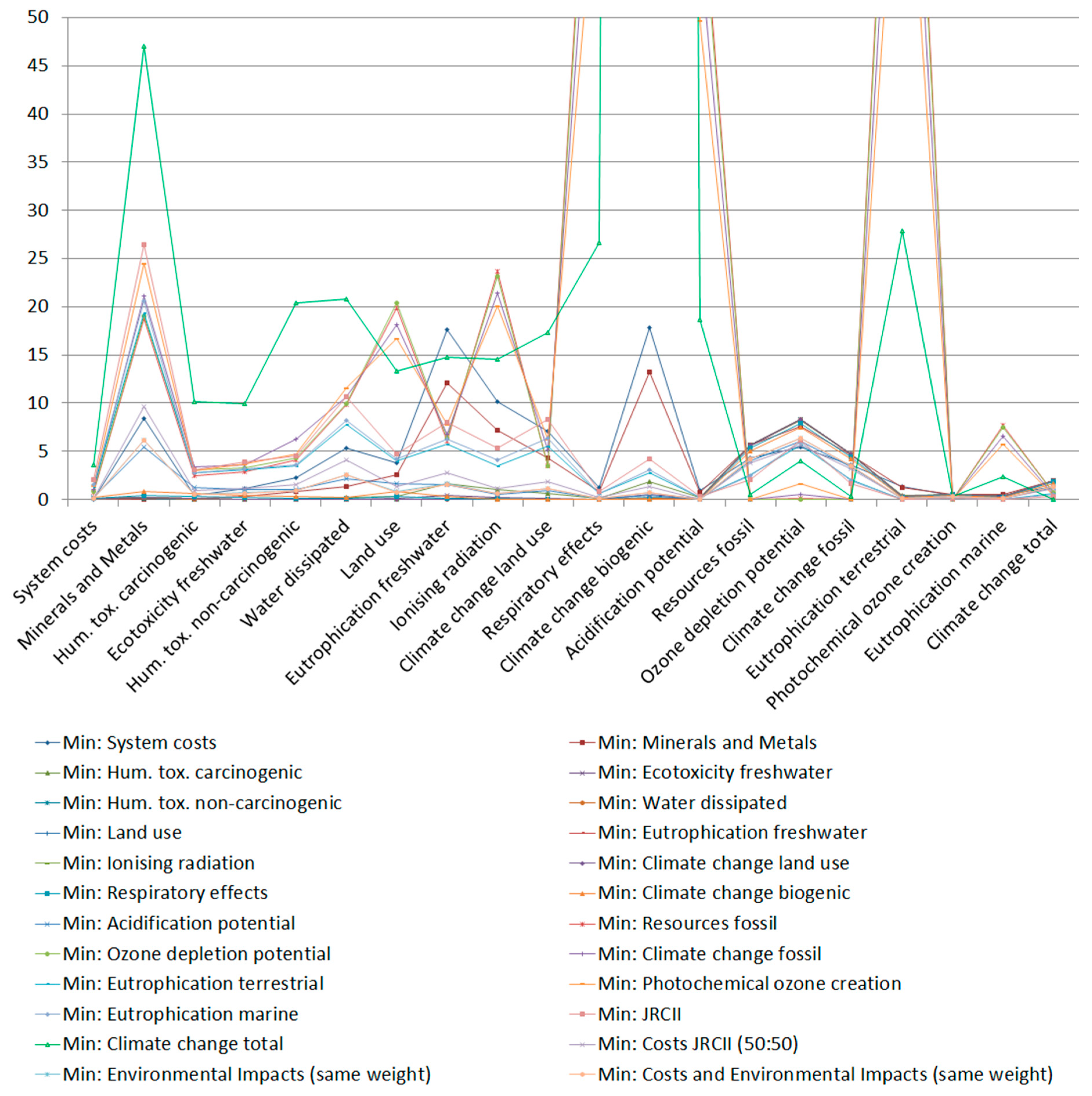
References
- Tang, C.F.; Tan, B.W.; Ozturk, I. Energy consumption and economic growth in Vietnam. Renew. Sustain. Energy Rev. 2016, 54, 1506–1514. [Google Scholar] [CrossRef]
- Belke, A.; Dreger, C.; Haan, F.D. Energy Consumption and Economic Growth. New Insights into the Cointegration Relationship; RWI: Essen, Germany, 2010; ISBN 9783867882149. [Google Scholar]
- Wang, S.; Li, Q.; Fang, C.; Zhou, C. The relationship between economic growth, energy consumption, and CO2 emissions: Empirical evidence from China. Sci. Total Environ. 2016, 542, 360–371. [Google Scholar] [CrossRef]
- IPCC. Climate Change 2014: Mitigation of Climate Change; Cambridge University Press: NewYork, NY, USA, 2014. [Google Scholar]
- Von Hirschhausen, C.; Gerbaulet, C.; Kemfert, C.; Reitz, F.; Ziehm, C. German nuclear phase-out enters the next stage: Electricity supply remains secure—Major challenges and high costs for dismantling and final waste disposal. DIW Econ. Bull. 2015, 5, 293–301. [Google Scholar]
- Goldemberg, J.; Johansson, T.B.; Anderson, D. World Energy Assessment. Overview: 2004 Update; United Nations Development Programme, Bureau for Development Policy: New York, NY, USA, 2004; ISBN 9789211261677. [Google Scholar]
- Heinrich-Böll-Stiftung; Green European Foundation; European Renewable Energy Federation; Le Monde Diplomatique. Energieatlas 2018; Heinrich-Böll-Stiftung: Berlin, Germany, 2018. [Google Scholar]
- McKenna, R.; Bertsch, V.; Mainzer, K.; Fichtner, W. Combining local preferences with multi-criteria decision analysis and linear optimization to develop feasible energy concepts in small communities. Eur. J. Oper. Res. 2018, 268, 1092–1110. [Google Scholar] [CrossRef]
- Zahedi, A. A review of drivers, benefits, and challenges in integrating renewable energy sources into electricity grid. Renew. Sustain. Energy Rev. 2011, 15, 4775–4779. [Google Scholar] [CrossRef]
- Fthenakis, V.; Kim, H.C. Land use and electricity generation: A life-cycle analysis. Renew. Sustain. Energy Rev. 2009, 13, 1465–1474. [Google Scholar] [CrossRef] [Green Version]
- Gagnon, L.; Bélanger, C.; Uchiyama, Y. Life-cycle assessment of electricity generation options: The status of research in year 2001. Energy Policy 2002, 30, 1267–1278. [Google Scholar] [CrossRef]
- Immendoerfer, A.; Tietze, I.; Hottenroth, H.; Viere, T. Life-cycle impacts of pumped hydropower storage and battery storage. Int. J. Energy Environ. Eng. 2017, 49, 4825. [Google Scholar] [CrossRef] [Green Version]
- Pehnt, M. Dynamic life cycle assessment (LCA) of renewable energy technologies. Renew. Energy 2006, 31, 55–71. [Google Scholar] [CrossRef]
- Rauner, S.; Budzinski, M. Holistic energy system modeling combining multi-objective optimization and life cycle assessment. Environ. Res. Lett. 2017, 12, 124005. [Google Scholar] [CrossRef]
- Lazar, L.; Tietze, I. Integrating energy system modelling and life cycle assessment for both cost and environmental optimisation of a decentralised regional energy system. In Proceedings of the Energy Challenges for the Next Decade, 16th IAEE European Conference, Ljubljana, Slovenia, 25–28 August 2019. [Google Scholar]
- Ringkjøb, H.-K.; Haugan, P.M.; Solbrekke, I.M. A review of modelling tools for energy and electricity systems with large shares of variable renewables. Renew. Sustain. Energy Rev. 2018, 96, 440–459. [Google Scholar] [CrossRef]
- Meyer, D.E.; Upadhyayula, V.K.K. The use of life cycle tools to support decision making for sustainable nanotechnologies. Clean Technol. Environ. Policy 2014, 16, 757–772. [Google Scholar] [CrossRef]
- Maxim, A. Sustainability assessment of electricity generation technologies using weighted multi-criteria decision analysis. Energy Policy 2014, 65, 284–297. [Google Scholar] [CrossRef]
- Kigle, S.; Pichlmaier, S.; Huber, J.; Regett, A. Ökobilanzen strombasierter synthetischer Kraftstoffe: Worauf es ankommt. EW 2019, 2019, 18–23. [Google Scholar]
- Yilmaz, O.; Anctil, A.; Karanfil, T. LCA as a decision support tool for evaluation of best available techniques (BATs) for cleaner production of iron casting. J. Clean. Prod. 2015, 105, 337–347. [Google Scholar] [CrossRef]
- Li, C.; Wang, N.; Zhang, H.; Liu, Q.; Chai, Y.; Shen, X.; Yang, Z.; Yang, Y. Environmental impact evaluation of distributed renewable energy system based on life cycle assessment and fuzzy rough sets. Energies 2019, 12, 4214. [Google Scholar] [CrossRef] [Green Version]
- Azapagic, A.; Stamford, L.; Youds, L.; Barteczko-Hibbert, C. Towards sustainable production and consumption: A novel decision-support framework integrating economic, environmental and social sustainability (DESIRES). Comput. Chem. Eng. 2016, 91, 93–103. [Google Scholar] [CrossRef]
- Su, M.; Chen, C.; Yang, Z. Urban energy structure optimization at the sector scale: Considering environmental impact based on life cycle assessment. J. Clean. Prod. 2016, 112, 1464–1474. [Google Scholar] [CrossRef]
- García-Gusano, D.; Garraín, D.; Dufour, J. Prospective life cycle assessment of the Spanish electricity production. Renew. Sustain. Energy Rev. 2017, 75, 21–34. [Google Scholar] [CrossRef]
- García-Gusano, D.; Iribarren, D.; Martín-Gamboa, M.; Dufour, J.; Espegren, K.; Lind, A. Integration of life-cycle indicators into energy optimisation models: The case study of power generation in Norway. J. Clean. Prod. 2016, 112, 2693–2696. [Google Scholar] [CrossRef] [Green Version]
- Vandepaer, L.; Cloutier, J.; Bauer, C.; Amor, B. Integrating batteries in the future Swiss electricity supply system: A consequential environmental assessment. J. Ind. Ecol. 2019, 23, 709–725. [Google Scholar] [CrossRef]
- Hilpert, S.; Kaldemeyer, C.; Krien, U.; Günther, S.; Wingenbach, C.; Plessmann, G. The open energy modelling framework (OEMOF)—A new approach to facilitate open science in energy system modelling. Energy Strategy Rev. 2018, 22, 16–25. [Google Scholar] [CrossRef] [Green Version]
- Ciroth, A.; Di Noi, C.l.; Lohse, T.; Srocka, M. openLCA 1.9 Comprehensive User Manual; GreenDelta GmbH: Berlin, Germany, 2019. [Google Scholar]
- Wernet, G.; Bauer, C.; Steubing, B.; Reinhard, J.; Moreno-Ruiz, E.; Weidema, B. The ecoinvent database version 3 (part I): Overview and methodology. Int. J. Life Cycle Assess. 2016, 21, 1218–1230. [Google Scholar] [CrossRef]
- Icons8 LLC. Free Icons. Available online: https://icons8.com/icons (accessed on 14 May 2019).
- International Organization for Standardization. Environmental Management—Life Cycle Assessment—Requirements and Guidelines; ISO 14044:2006; ISO: Geneva, Switzerland, 2006. [Google Scholar]
- International Organization for Standardization. Environmental Management—Life Cycle Assessment—Principles and Framework; ISO 14040:2006; ISO: Geneva, Switzerland, 2006. [Google Scholar]
- European Commission, Joint Research Centre. Reference Life Cycle Data System (ILCD) Handbook—General Guide for Life Cycle Assessment—Detailed Guidance; Publications Office of the European Union: Luxembourg, 2010. [Google Scholar]
- Fazio, S.; Castellani, V.; Sala, S.; Schau, E.M.; Secchi, M.; Zampori, L.; Diaconu, E. Supporting Information to the Characterisation Factors of Recommended EF Life Cycle Impact Assessment Method: New Models and Differences with ILCD; Publications Office of the European Union: Luxembourg, 2018. [Google Scholar]
- PyPi. olca-ipc 0.0.7. Available online: https://pypi.org/project/olca-ipc/ (accessed on 13 May 2019).
- Sala, S.; Crenna, E.; Secchi, M.; Pant, R. Global Normalisation Factors for the Environmental Footprint and Life Cycle Assessment; Publications Office of the European Union: Luxembourg, 2017. [Google Scholar]
- Huppes, G.; van Oers, L. Evaluation of Weighting Methods for Measuring the EU-27 Overall Environmental Impact; Publications Office of the European Union: Luxembourg, 2011. [Google Scholar]
- Peters, J.F.; Weil, M. Providing a common base for life cycle assessments of Li-Ion batteries. J. Clean. Prod. 2018, 171, 704–713. [Google Scholar] [CrossRef]
- Weber, S.; Peters, J.F.; Baumann, M.; Weil, M. Life cycle assessment of a vanadium redox flow battery. Environ. Sci. Technol. 2018, 52, 10864–10873. [Google Scholar] [CrossRef] [PubMed]
- Fraunhofer ISE. Energy Charts. 2019. Available online: https://www.energy-charts.de (accessed on 10 December 2018).
- Bundesnetzagentur. Biogas—Monitoringbericht 2014: Bericht der Bundesnetzagentur über die Auswirkungen der Sonderregelungen für die Einspeisung von Biogas in das Erdgasnetz; Bundesnetzagentur: Bonn, Germany, 2014.
- Bundesnetzagentur. Monitoringbericht 2017; Bundesnetzagentur: Bonn, Germany, 2017.
- Klein, C.; Rozanski, K.; Gailfuß, M.; Kukuk, J.; Beck, T. BHKW-Kenndaten 2014/2015: Module, Anbieter, Kosten; ASUE: Berlin, Germany, 2014. [Google Scholar]
- Wirth, H. Aktuelle Fakten zur Photovoltaik in Deutschland. Fassung vom 18.03.2019; Fraunhofer ISE: Freiburg, Germany, 2019. [Google Scholar]
- European Commission. Photovoltaic Geographical Information System (PVGIS). Available online: http://re.jrc.ec.europa.eu/pvg_tools/en/tools.html#PVP (accessed on 13 May 2019).
- IRENA. Renewable Power Generation Costs in 2017; International Renewable Energy Agency: Abu Dhabi, UAE, 2018. [Google Scholar]
- Baumann, M.; Peters, J.; Weil, M. Ökologische und ökonomische Performance stationärer Li-ion-Batteriespeicher. In Proceedings of the 15. Symposium Energieinnovation, Gratz, Austria, 14–16 February 2018. [Google Scholar]
- Peters, J.; Baumann, M.; Zimmermann, B.; Braun, J.; Weil, M. The environmental impact of Li-Ion batteries and the role of key parameters—A review. Renew. Sustain. Energy Rev. 2017, 67, 491–506. [Google Scholar] [CrossRef]
- Tajden, T.; Bergner, J.; Weniger, J.; Quaschning, V. Representative Electrical Load Profiles of Residential Buildings in Germany with a Temporal Resolution of One Second; HTW Berlin—University of Applied Sciences: Berlin, Germany, 2015. [Google Scholar]
- DWD. Climate Data Center. Available online: https://cdc.dwd.de/portal/201809260905/index.html (accessed on 13 May 2019).
- Wikner, E.; Thiringer, T. Extending battery lifetime by avoiding high SOC. Appl. Sci. 2018, 8, 1825. [Google Scholar] [CrossRef] [Green Version]
- Bobba, S.; Mathieux, F.; Ardente, F.; Blengini, G.A.; Cusenza, M.A.; Podias, A.; Pfrang, A. Life cycle assessment of repurposed electric vehicle batteries: An adapted method based on modelling energy flows. J. Energy Storage 2018, 19, 213–225. [Google Scholar] [CrossRef]
- Jongerden, M.R.; Haverkort, B.R. Battery aging, battery charging and the kinetic battery model: A first exploration. In Proceedings of the Quantitative Evaluation of Systems: 14th International Conference, QEST 2017, Berlin, Germany, 5–7 September 2017; pp. 88–103, ISBN 9783319663357. [Google Scholar]
- Barcellona, S.; Piegari, L. Lithium ion battery models and parameter identification techniques. Energies 2017, 10, 2007. [Google Scholar] [CrossRef] [Green Version]
- Vandepaer, L.; Treyer, K.; Mutel, C.; Bauer, C.; Amor, B. The integration of long-term marginal electricity supply mixes in the ecoinvent consequential database version 3.4 and examination of modeling choices. Int. J. Life Cycle Assess. 2019, 24, 1409–1428. [Google Scholar] [CrossRef] [Green Version]
- Deetman, S.; Pauliuk, S.; van Vuuren, D.P.; van der Voet, E.; Tukker, A. Scenarios for demand growth of metals in electricity generation technologies, cars, and electronic appliances. Environ. Sci. Technol. 2018, 52, 4950–4959. [Google Scholar] [CrossRef] [PubMed] [Green Version]
- Hertwich, E.G.; Gibon, T.; Bouman, E.A.; Arvesen, A.; Suh, S.; Heath, G.A.; Bergesen, J.D.; Ramirez, A.; Vega, M.I.; Shi, L. Integrated life-cycle assessment of electricity-supply scenarios confirms global environmental benefit of low-carbon technologies. Proc. Natl. Acad. Sci. USA 2015, 112, 6277–6282. [Google Scholar] [CrossRef] [PubMed] [Green Version]
- Lieberei, J.; Gheewala, S.H. Resource depletion assessment of renewable electricity generation technologies—Comparison of life cycle impact assessment methods with focus on mineral resources. Int. J. Life Cycle Assess. 2017, 22, 185–198. [Google Scholar] [CrossRef]
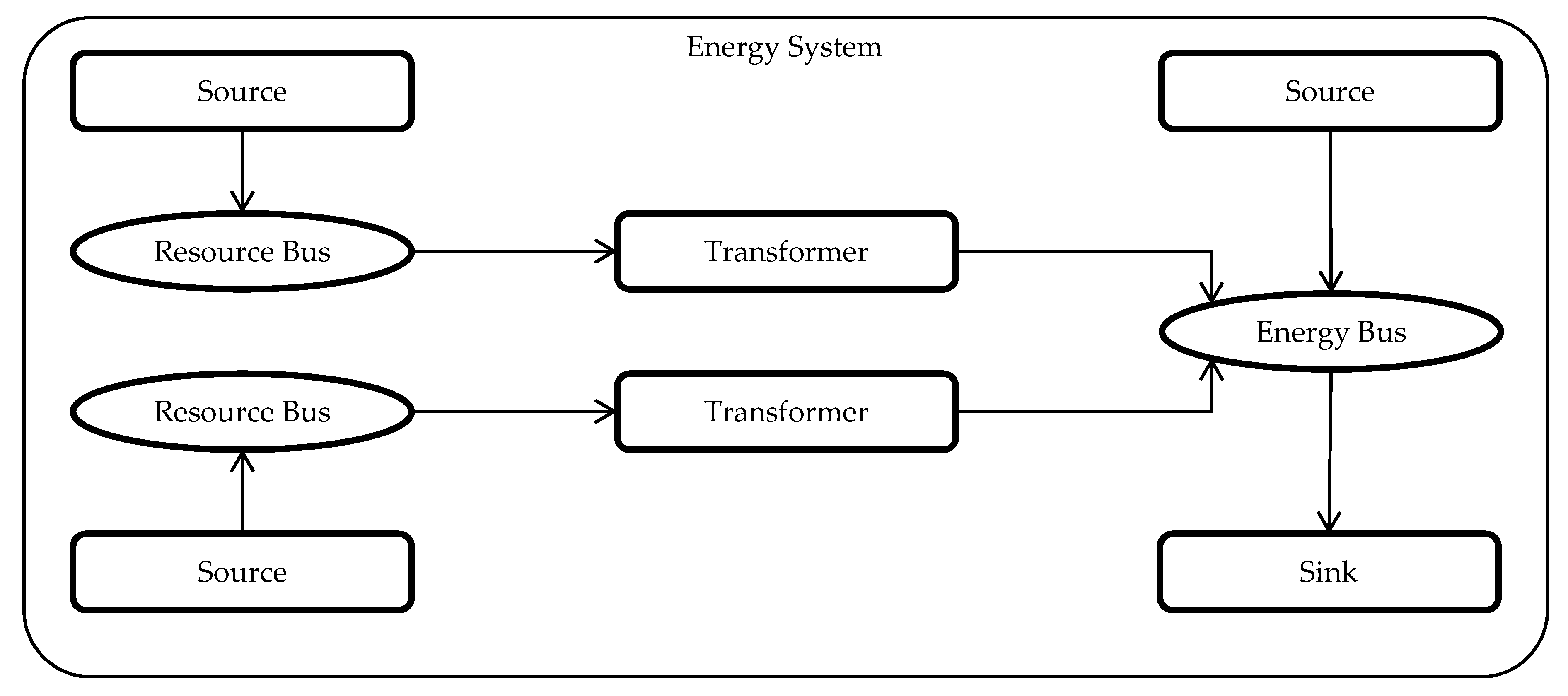

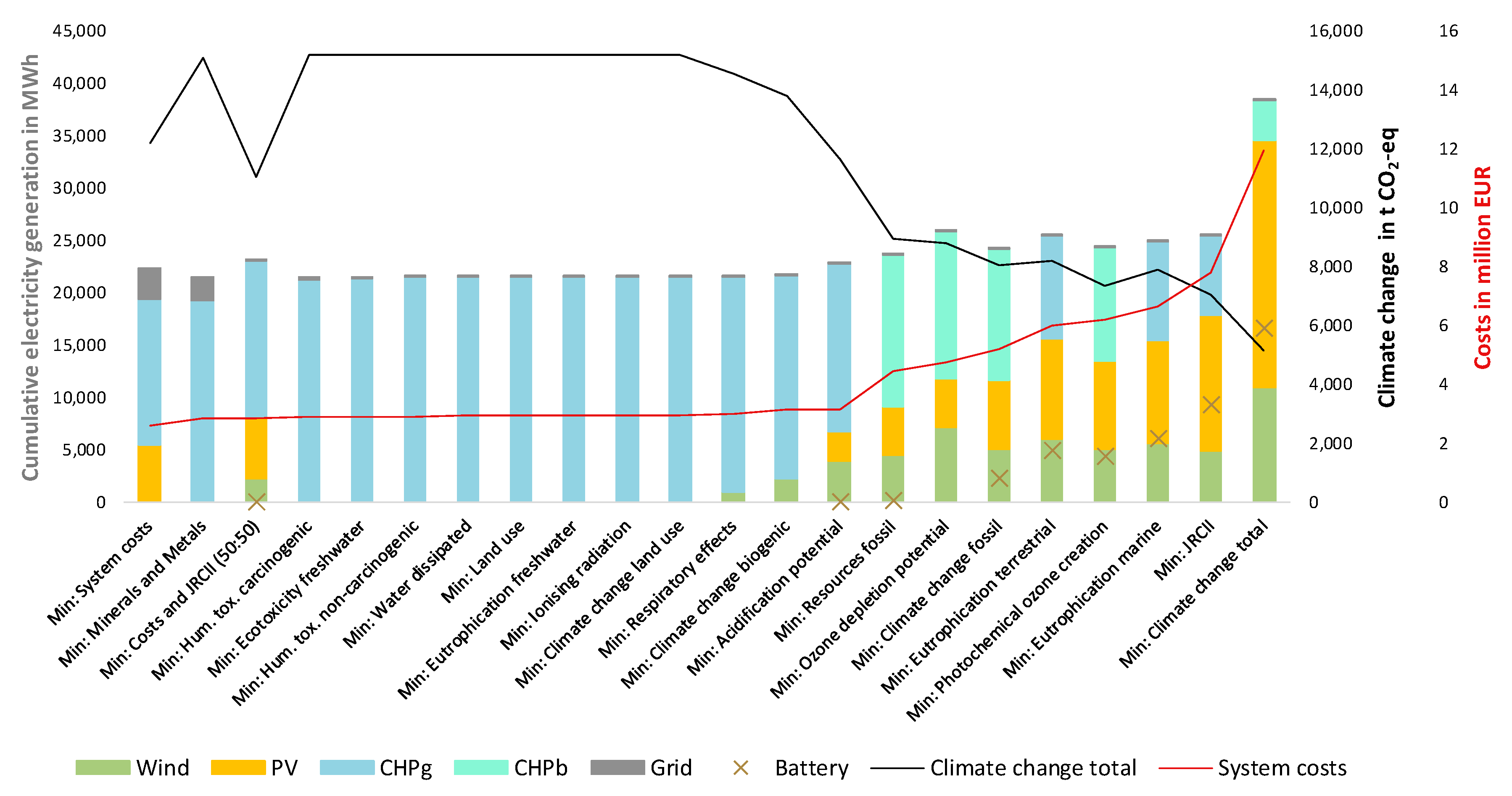

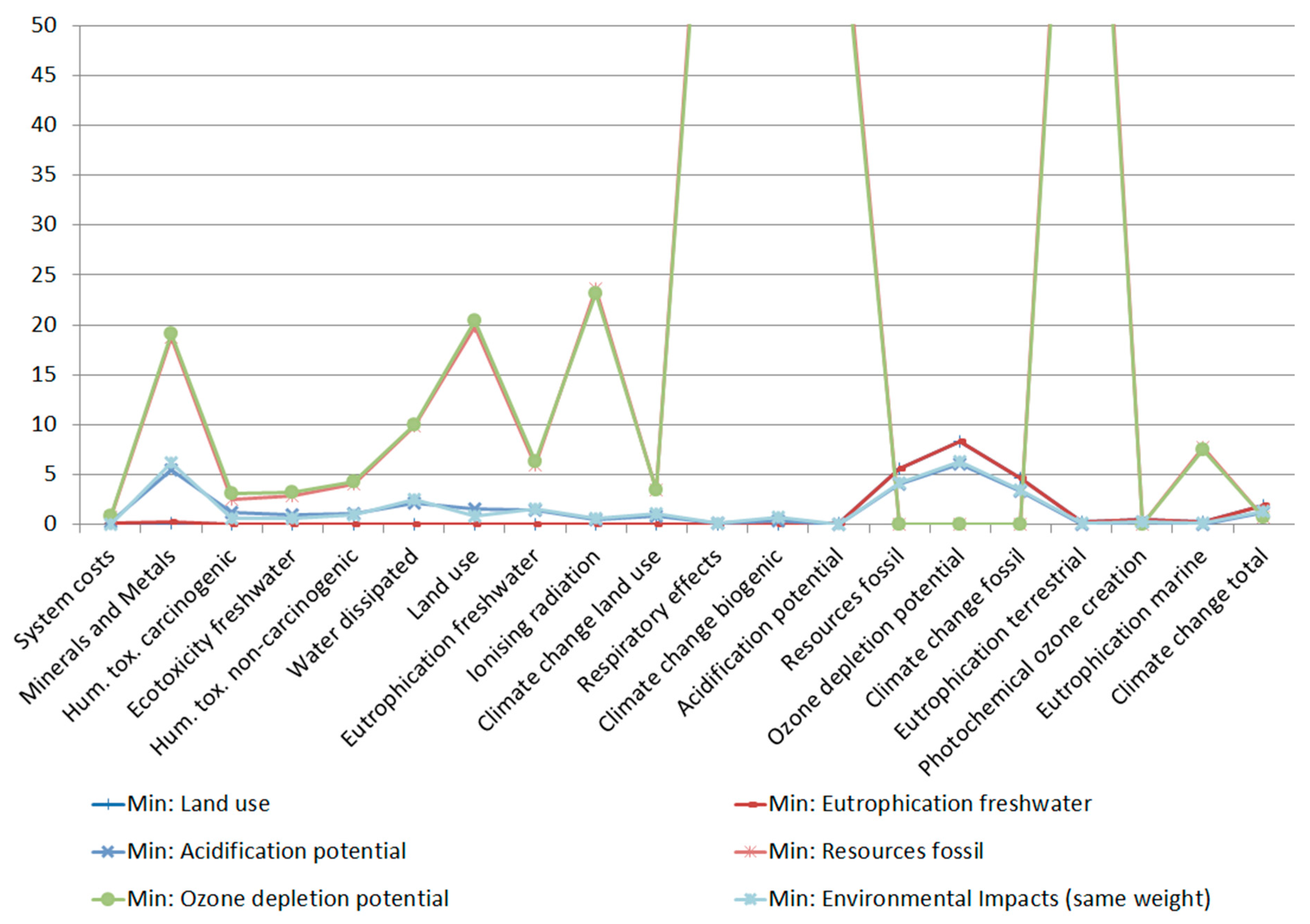

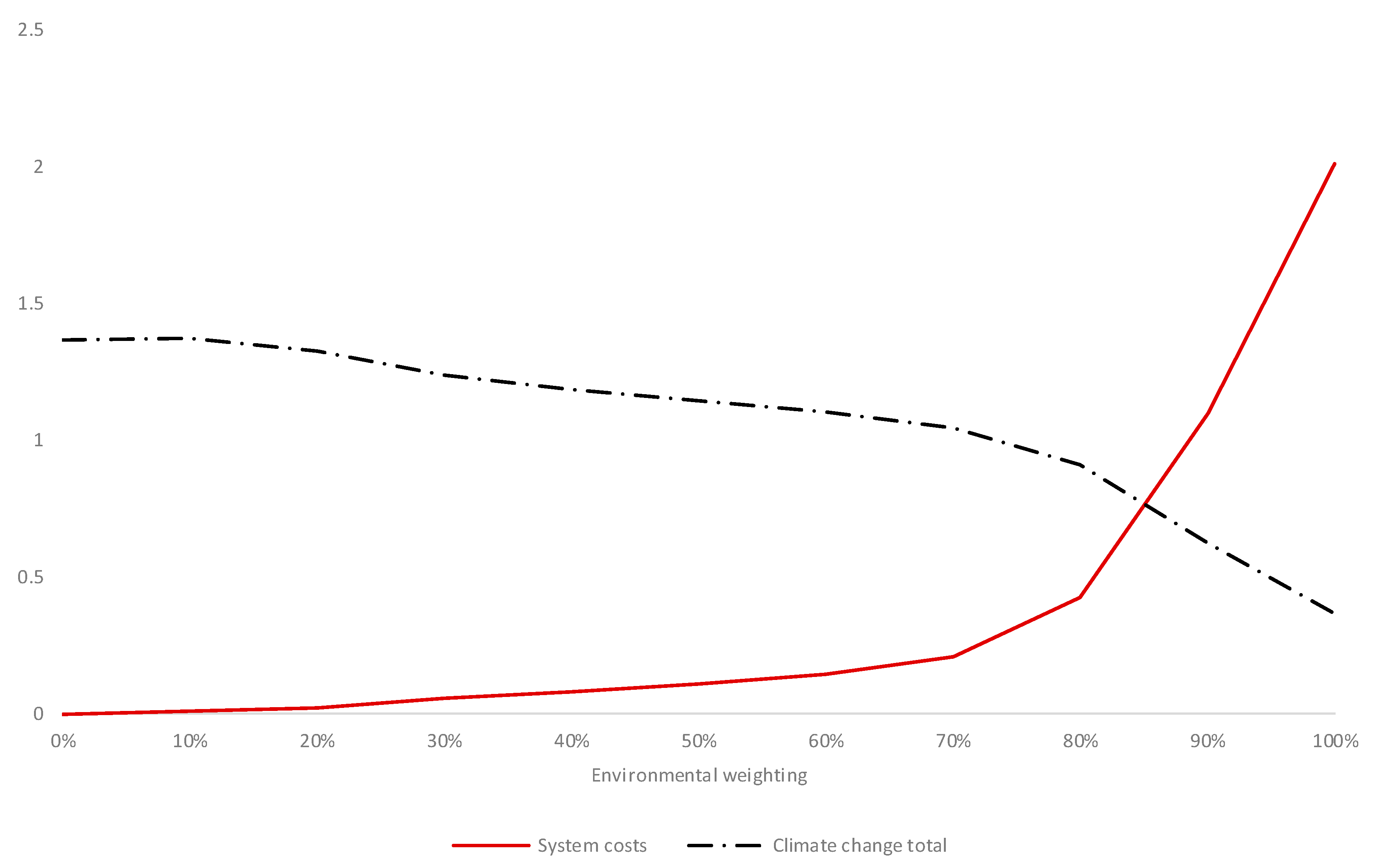
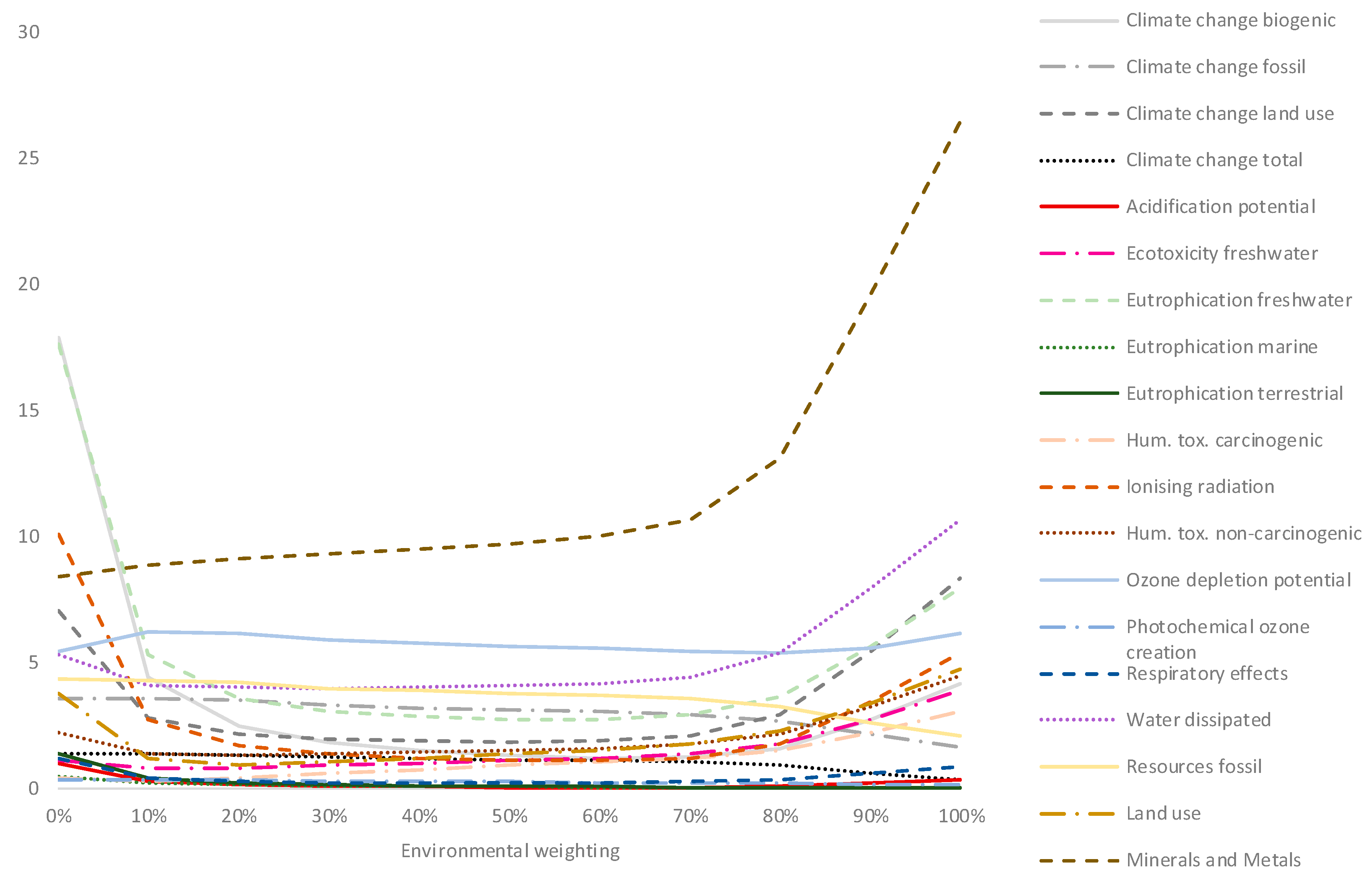
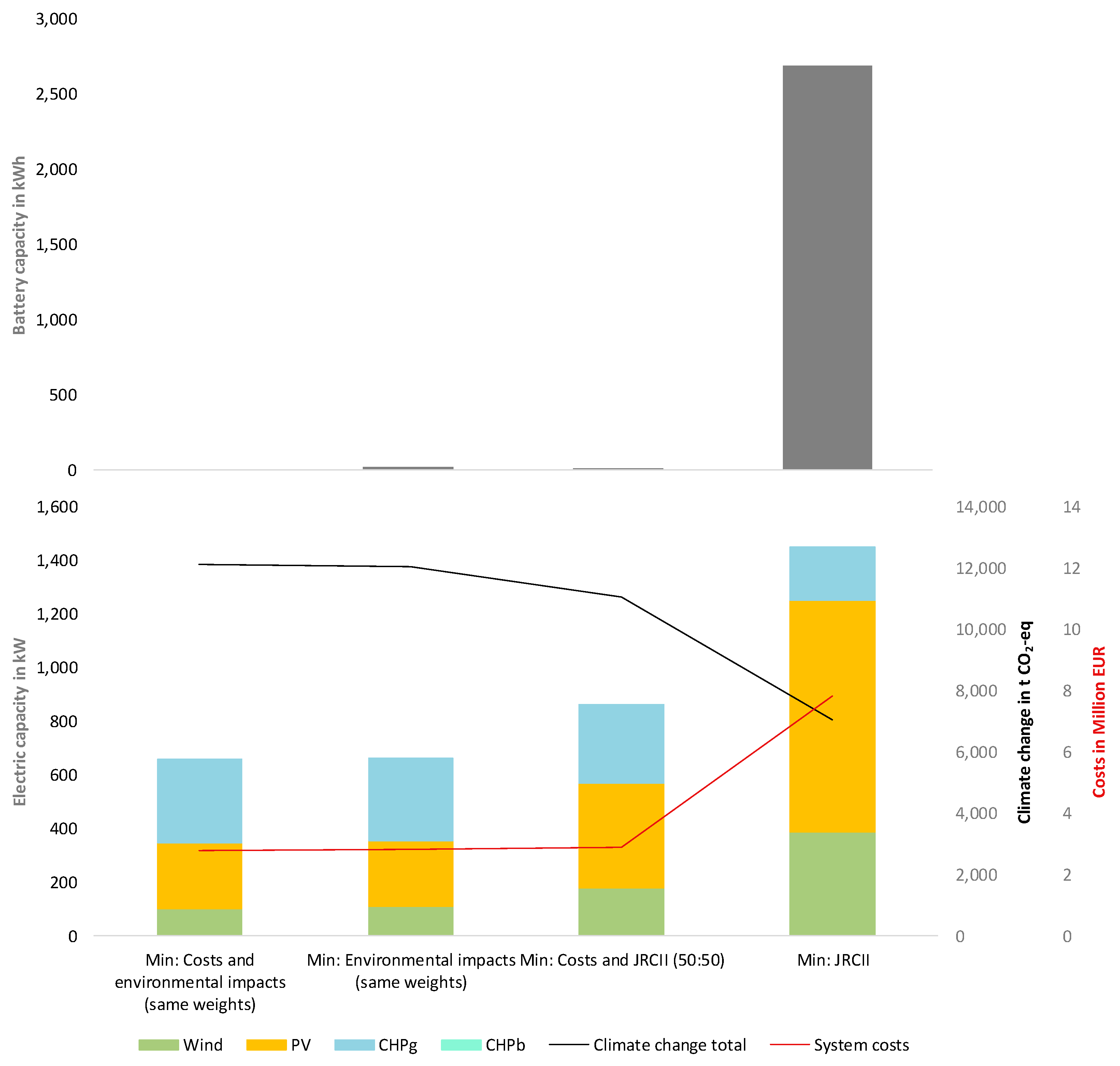
| Technology | Variable Costs [€/kWhel] | Fixed Costs [€/kWel/a] | Investment [€/kWel, €/kWp for PV, €/kWh for LFP and VRF] | Efficiency | Lifetime | Reference |
|---|---|---|---|---|---|---|
| CHP natural gas | 0.01 | N/A | 1148 | el. 37%, th. 49 % | 20 years | [43] |
| CHP biogas | 0.02 | N/A | 1148 | el. 39%, th. 49 % | 20 years | [43] |
| PV | N/A | 130 | 1300 | 14% | 30 years | [44,45] |
| Wind | 0.03 * | 59 * | 1558 * | N/A | 20 years | [46] |
| LFP | N/A | 25 | 1949 | 90%, 1C | 8000 cycles | [47,48] |
| VRF | N/A | 40 | 1507 | 75%, 1C | 10,000 cycles | [47,48] |
© 2020 by the authors. Licensee MDPI, Basel, Switzerland. This article is an open access article distributed under the terms and conditions of the Creative Commons Attribution (CC BY) license (http://creativecommons.org/licenses/by/4.0/).
Share and Cite
Tietze, I.; Lazar, L.; Hottenroth, H.; Lewerenz, S. LAEND: A Model for Multi-Objective Investment Optimisation of Residential Quarters Considering Costs and Environmental Impacts. Energies 2020, 13, 614. https://doi.org/10.3390/en13030614
Tietze I, Lazar L, Hottenroth H, Lewerenz S. LAEND: A Model for Multi-Objective Investment Optimisation of Residential Quarters Considering Costs and Environmental Impacts. Energies. 2020; 13(3):614. https://doi.org/10.3390/en13030614
Chicago/Turabian StyleTietze, Ingela, Lukas Lazar, Heidi Hottenroth, and Steffen Lewerenz. 2020. "LAEND: A Model for Multi-Objective Investment Optimisation of Residential Quarters Considering Costs and Environmental Impacts" Energies 13, no. 3: 614. https://doi.org/10.3390/en13030614




